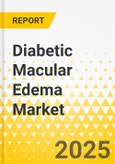This report comes with 10% free customization, enabling you to add data that meets your specific business needs.
The Global Diabetic Macular Edema Market is witnessing strong growth due to several converging factors. Rising prevalence of diabetes, particularly type 2 diabetes, is the primary driver of market expansion, as longer disease duration and poor glycemic control increase the risk of developing diabetic retinopathy and associated macular edema. Technological advancements in ophthalmic diagnostics, such as optical coherence tomography (OCT), fundus photography, and AI-enabled retinal imaging, are enabling early and accurate detection of retinal changes, allowing clinicians to intervene promptly. Moreover, increasing awareness among patients and healthcare providers regarding the importance of regular retinal screening is contributing to improved diagnosis rates and earlier treatment initiation.
Treatment modalities for DME are evolving rapidly. Anti-VEGF (vascular endothelial growth factor) therapy remains the standard of care, significantly reducing retinal swelling and improving visual acuity. Corticosteroids are used in patients with refractory DME or those who respond poorly to anti-VEGF therapy. Laser photocoagulation, once the primary treatment, now serves primarily as an adjunct therapy to prevent further retinal damage. Emerging therapies, including sustained-release implants, novel biologics, and combination regimens, are under clinical investigation to address unmet needs such as reducing treatment frequency and improving long-term efficacy. The route of administration predominantly includes intravitreal injections, which allow direct drug delivery to the retina; systemic and topical administration are limited but are areas of ongoing research.
The competitive landscape is marked by active participation from both global pharmaceutical giants and specialized ophthalmology-focused companies. Companies such as F. Hoffmann-La Roche Ltd, Novartis AG, Bayer AG, Pfizer Inc., are at the forefront of DME research and product development. These companies are investing heavily in clinical trials, strategic partnerships, mergers and acquisitions, and product innovation to strengthen their market positions. Additionally, healthcare providers are increasingly integrating digital monitoring systems and AI-assisted diagnostic tools to improve patient management and treatment outcomes.
Despite significant progress, several challenges constrain market growth. Frequent intravitreal injections can reduce patient compliance, while high treatment costs and limited access to advanced ophthalmic care in emerging markets pose additional barriers. Furthermore, variability in patient response to therapy, risk of injection-related complications, and lack of universally standardized treatment protocols can hinder consistent outcomes.
Nevertheless, the Global Diabetic Macular Edema Market presents substantial growth opportunities. Emerging markets, especially in Asia-Pacific and Latin America, are witnessing increasing healthcare expenditure, improving infrastructure, and greater access to ophthalmic care, creating a favorable environment for advanced therapies. Investment in R&D for novel treatment modalities, including sustained-release formulations and next-generation biologics, is expected to drive innovation. Government initiatives promoting diabetic eye care, regular retinal screenings, and awareness programs further support market expansion.
Market Segmentation:
Segmentation 1: by Route of Administration
- Intravitreal Injection
- Topical
- Systemic
Segmentation 2: by Distribution Channel
- Hospital Pharmacies
- Retail Pharmacies
- Online Pharmacies
Segmentation 3: by Region
- North America
- Europe
- Asia-Pacific
This product will be updated with the latest data at the time of order. Consequently, dispatch time for this product will be 7-10 business days.
Table of Contents
Companies Mentioned
- Amneal Pharmaceuticals LLC.
- F. Hoffmann-La Roche Ltd
- Lupin
- Santen Pharmaceutical
- Novartis AG
- Bayer AG








